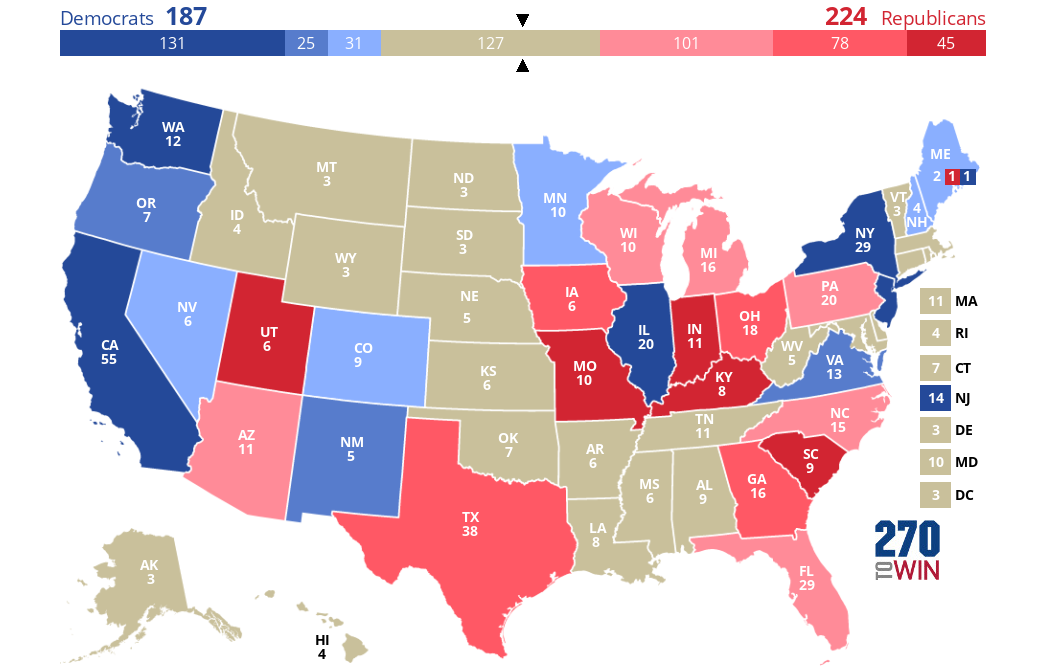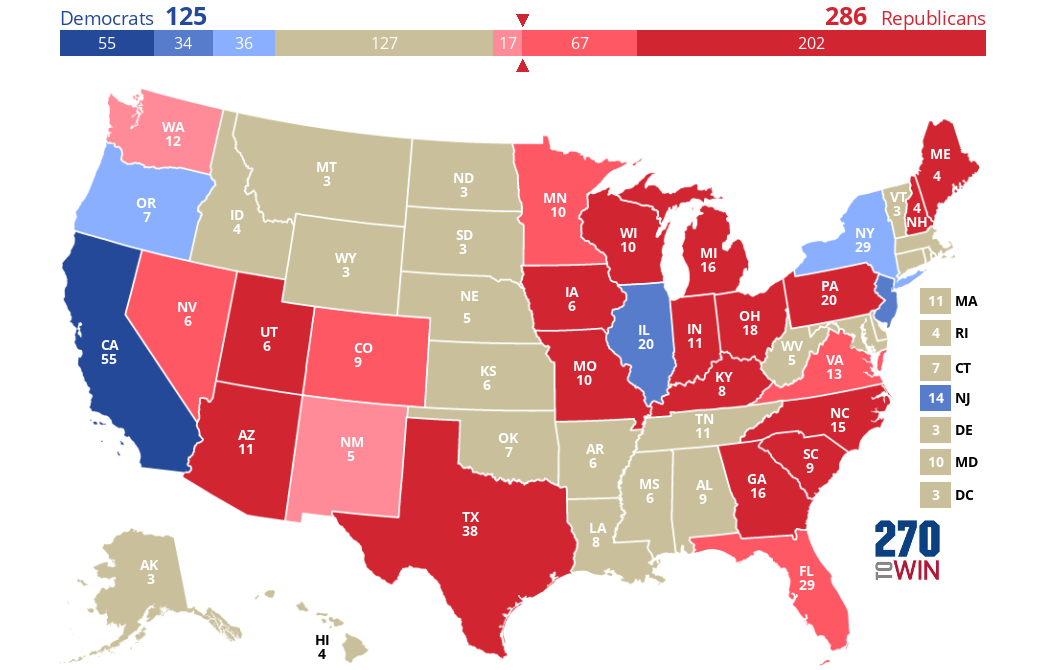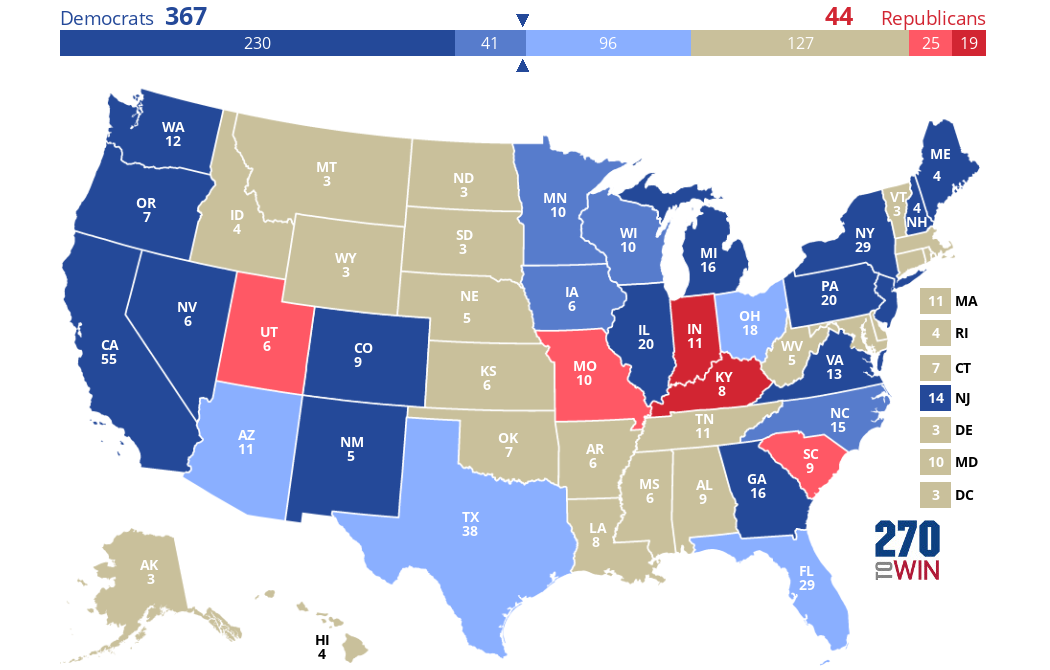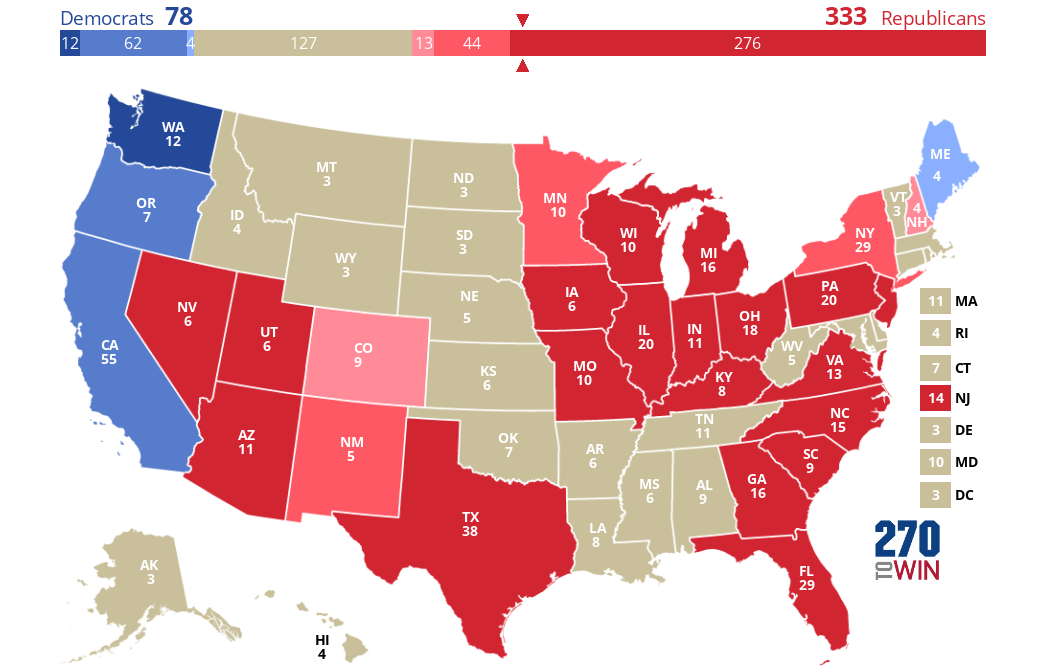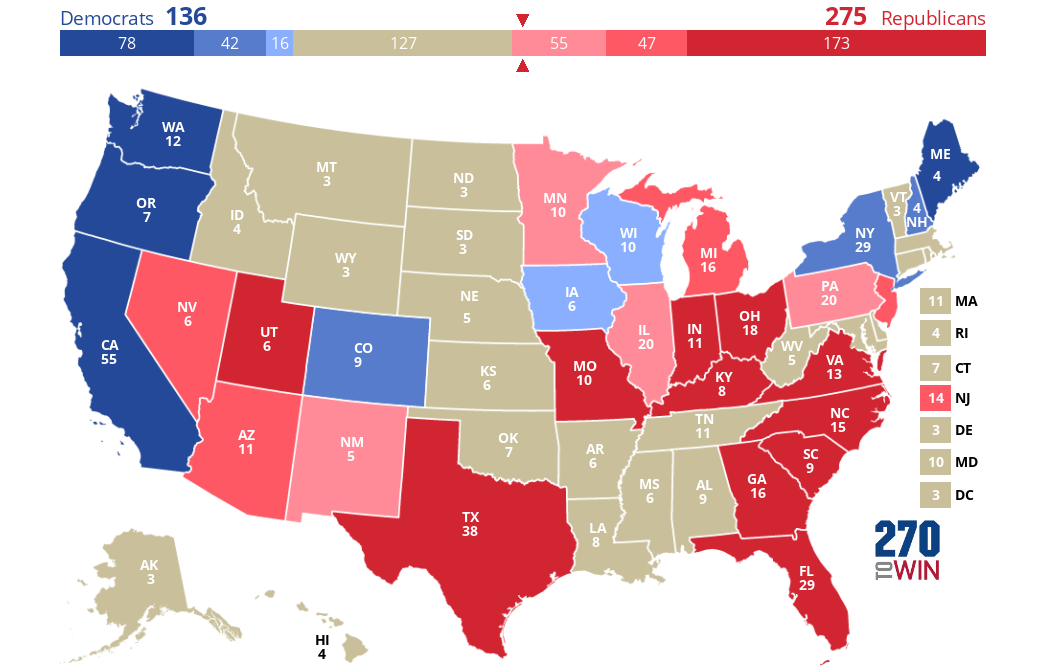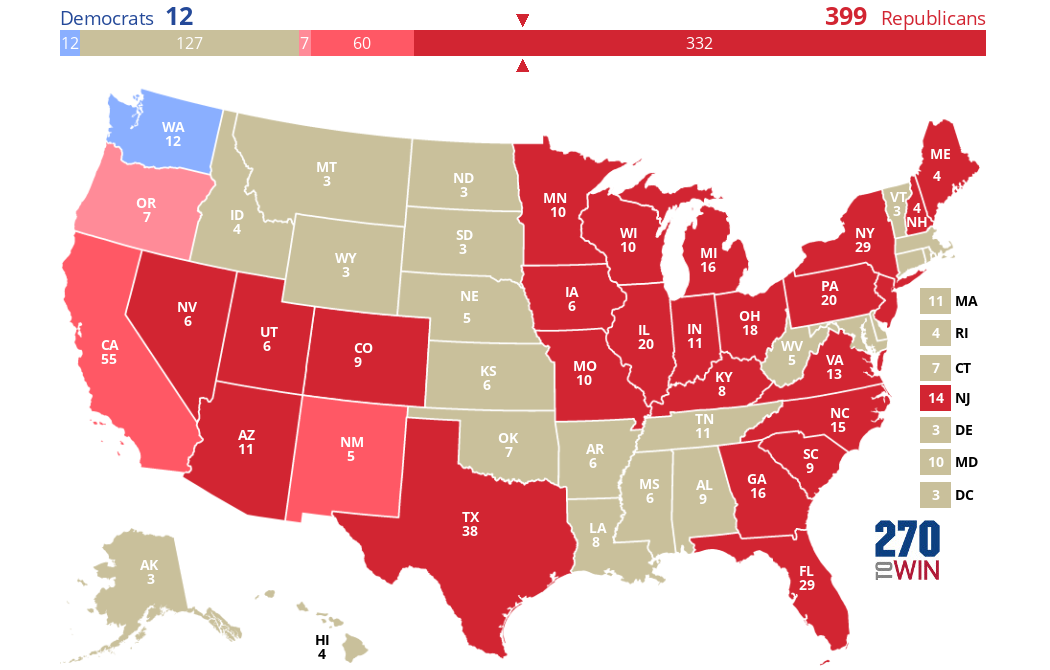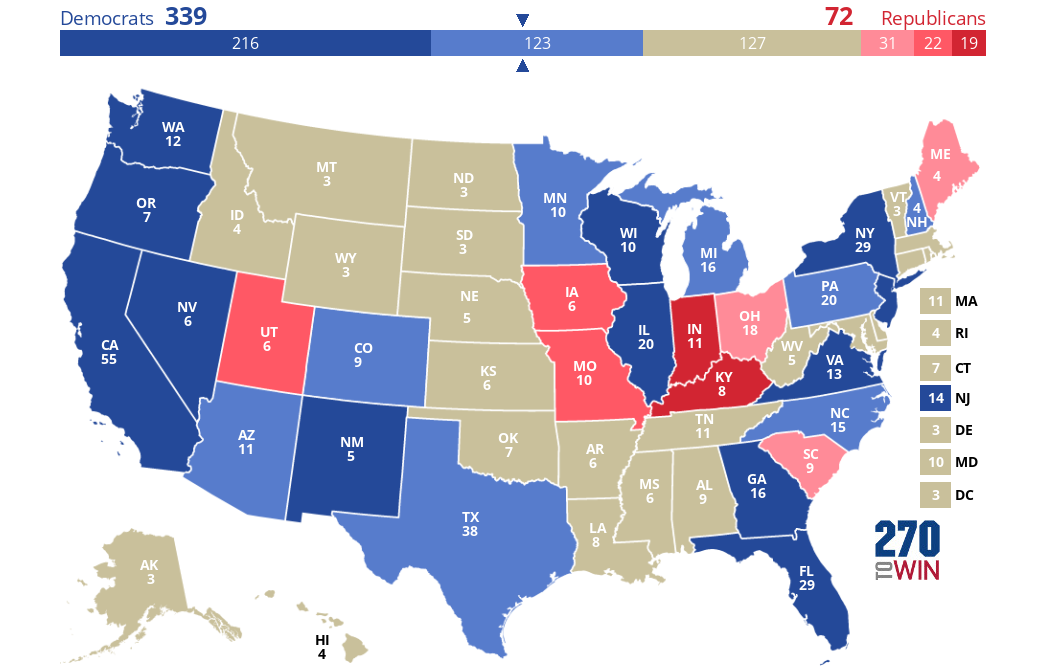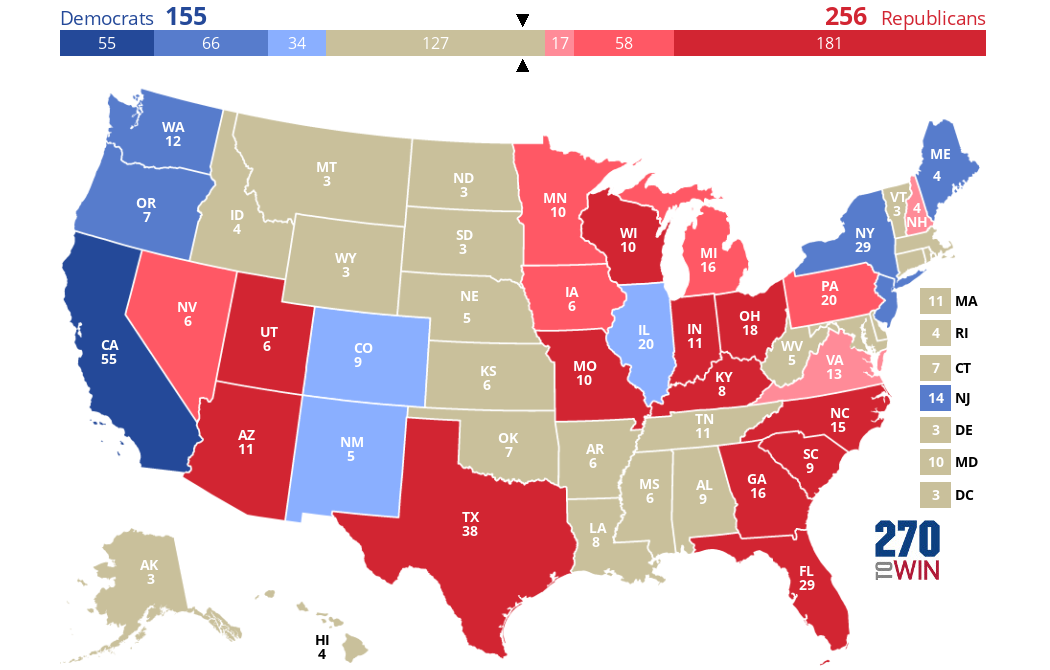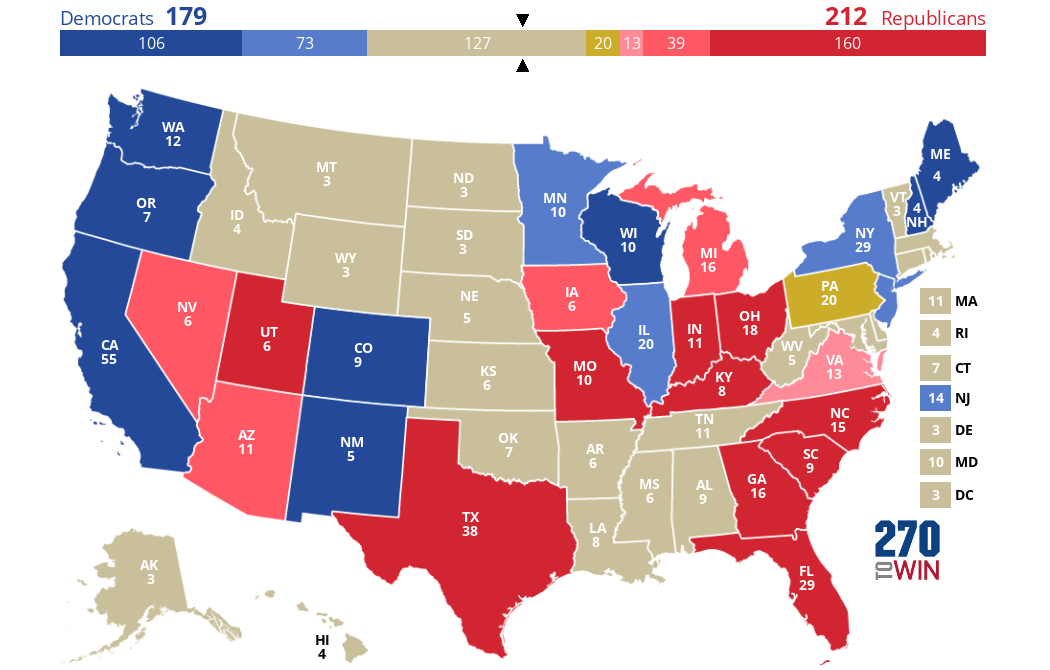Need to understand a controversial human biology/genetics/psychology topic? You've come to the right place! That's because I know everything there is to know about everything and am uniquely endowed with the ability to perfectly describe EVERY science topic. What? Sarcasm? I don't even know what that is!
Monday, March 18, 2019
On the representativeness of exit polls II: the 2018 gubernatorial elections
Kemp = (.52*.46)+(.49*.54) = 50.4%, so 0.2% high.
Abrams = (.46*.46)+(.51*.54) = 48.7%, so 0.1% low.
For age (4):
Kemp = 49.9%, so 0.3% low.
Abrams = 48.8%, so exactly right.
For age (6):
Kemp = 49.7%, so 0.5% low.
Abrams = 48.0%, so 0.8% low.
Using the Excel spreadsheet I just threw together it is easy to calculate estimates for any race if you have the exit poll results (% of voters in each group and voting results by group). If you do it for the FL governor's race (won 49.6%-49.2% by the Republican Ron DeSantis; CNN's exit poll is here), you get this:
Gender: DeSantis = 49.8% (0.2% high), Gillum 48.7% (0.5% low).
Age (4): DeSantis = 49.9% (0.3% high), Gillum 48.8% (0.4% low).
Age (6): DeSantis = 49.0% (0.2% low), Gillum 48.3% (0.9% low).
For this Age (6) poll, the probable reason the estimates for both are a bit low is that 4% of 30-39 year old voters responded "No Answer" when asked who they voted for. Was this because they voted for a third-party/independent candidate, or did they not vote (for governor at least) at all? Probably a combination of both, but some of them probably just didn't answer even though they actually voted for DeSantis or Gillum.
CA: Democrat Newsom won the governor's race in CA with 61.9% of the vote to 38.1% for Republican Cox. Notably, it seems like these were the only two candidates on the ballot because of CA's weird runoff system, so 100% of all votes were for one or the other. Because some exit poll results have at least 1% of respondents refusing to answer we have to make all percentages based on the % of respondents who did answer (100%-the % who didn't answer).
Using CNN's exit poll for that state yields these estimates for the results (all errors are +/- based on value of (estimated-actual)):
Gender: Newsom 60.9% (-1%), Cox 39.1% (+1%)
Age (4): Newsom 60.8% (-1.1%), Cox 39.2% (+1.1%)
Age (6): Newsom 60.7% (-1.2%), Cox 39.3% (+1.2%)
If only X could vote
Let's start by taking the actual 2016 EV results (recall they were 306 Trump, 232 Clinton) and grey out all the states that CNN does not have exit polls at all for. As you can see plenty of states are grayed out--mostly ones Trump won in the Great Plains/Western area, as well as some Trump-loving southern states and a few liberal ones in the Northeast. The 2016 exit poll included 28 states, excluding 22 states and DC. In total, we see Trump with 224 EVs and Clinton with 187, so no one has enough to win here:
- White men
- White people overall
- Men overall
- White women
- People 45/older
- The American electorate overall
- White college graduates
- People under the age of 45
- Women overall
Monday, March 11, 2019
Why do hereditarians love the word "empirical" so much?
In this post I cite examples of hereditarian IQ/race/genetics researchers (Robert Plomin, Ian Deary, etc.) using appeals to "empirical" evidence to support their views. Their use of the word "empirical" specifically to defend themselves against their critics recurs weirdly often to the point where they seem to "get off" on using this word. And often their uses of it seem entirely redundant in the context in question. All emphases that follow are mine.
Example 1: "Concerning the equal environments assumption in general, empirical data based on most twin studies ever published point to little or no influence of shared environmental factors on twin similarity" (Arden et al. 2016).
Example 2: "A theoretical logic provides a useful framework for considering the empirically discovered links between intelligence and health. This framework is useful in generating empirical research questions such as ours" (Arden et al. 2016).
Example 3: [After describing E.G. Boring's 1923 quote "Intelligence is what the tests test"] "The apparently dismissive comment
came after a summary of strong empirical findings — for example, that the tests
showed marked individual differences, that the differences were stable over time, that
children developed greater intelligence over time but tended to maintain the same
rank order" (Deary et al. 2010, p. 202).
Example 4: "[Psychologist Howard] Gardner has intentionally avoided empirical tests of his theory [of multiple intelligences or MI], but those that have been made show most
of his MI to be correlated with one another...The theories that do not accommodate this finding [referring to the positive correlations between different mental tests] — such as those of Thurstone, Guilford, Sternberg
and Gardner — fail the most basic empirical tests" (Deary et al. 2010, p. 204).
Example 5: "More than 100 years of empirical research provide conclusive evidence that a general factor of intelligence (also known as g, general cognitive ability, mental ability and IQ (intelligence quotient)) exists, despite some claims to the contrary" (Deary et al. 2010, "Key points").
Example 6: "...we estimated the heritability of height from empirical genome-wide identity-by-descent sharing..." (Visscher et al. 2006)
Example 7: "...the empirical variance of IBD sharing is likely to be an underestimate because the marker information was not perfect" (Visscher et al. 2006).
Example 8: "They also failed to highlight that the theoretical discussion actually revolved around
an empirically testable question...To conduct the test, I drew on an empirical model..." (Littvay 2012)
Example 9: "The findings place the burden on critics to present theoretical work on the specific mechanisms of EEA violations based on which additional empirical assessments could (and should) be conducted." (Littvay 2012)
Example 10: "...these criticisms, like most of the literature questioning the validity of the EEA [equal environments assumption], are made on the basis of secondary analysis of published research, not on the basis of empirical examination of CTD [classical twin design] assumptions on political variables." (Smith et al. 2012, p. 19)
Sunday, March 3, 2019
On the representativeness of exit polls I: the 2016 general presidential election
I will start with my own state, Georgia. So what actually happened in this state was that Trump got 50.4% of the vote, while Clinton got 45.3%. So if we look at the gender exit polls for Georgia, we see the following:
- 55% of voters were female, 45% were male.
- Of the female voters, 54% voted for Clinton, while 43% chose Trump.
- Conversely, of the male voters, 60% chose Trump while only 37% chose Clinton.
- P(M) = 0.45,
- P(C|M) = 0.37,
- P(T|M) = 0.6,
- P(F) = 0.55,
- P(C|F) = 0.54, and
- P(T|F) = 0.43.
| Georgia | C | T | How far off (Clinton)? | How far off (Trump)? |
| Actual | 45.3% | 50.4% | ||
| Sex | 46.4% | 50.7% | 1.1% | 0.3% |
| Race (2) | 45.8% | 50.6% | 0.5% | 0.2% |
| Age (2) | 45.8% | 50.8% | 0.5% | 0.4% |
| Age (6) | 46.0% | 50.7% | 0.7% | 0.3% |
| Age (4) | 46.2% | 50.6% | 0.9% | 0.2% |
| Race (5)* | 42.0% | 48.8% | -3.3% | -1.6% |
| Race & gender | 43.8% | 50.3% | -1.5% | -0.2% |
| Arizona | C | T | How far off (Clinton)? | How far off (Trump)? |
| Actual | 44.6% | 48.1% | ||
| Sex | 44.6% | 48.9% | 0.0% | 0.8% |
| Race (2) | 44.8% | 48.5% | 0.2% | 0.4% |
| Age (2) | 44.7% | 48.9% | 0.1% | 0.8% |
| Age (6)* | 37.6% | 44.3% | -7.0% | -3.8% |
| Age (4) | 44.4% | 48.5% | -0.2% | 0.4% |
| Race (5)* | 39.2% | 45.2% | -5.4% | -3.0% |
| Race & gender* | 39.7% | 44.6% | -4.9% | -3.5% |
| Education (4) | 44.7% | 48.8% | 0.1% | 0.7% |
| Education (2) | 44.5% | 48.5% | -0.1% | 0.4% |
Lastly, I included California exit poll results (also from CNN) because it is the most-populated state, so surely they should be especially accurate there.
My results for the entire country, as well as for AZ, CA, and GA, are shown below. Note that these results include only the MOV as estimated from each exit poll category (sex, race (2), etc.), not the % estimated for either candidate. Overall we see that the exit polls seem to be very representative. We see that excluding missing data (corresponding to all values shown in red below) makes both the AZ and CA exit polls more accurate, but it has no effect for the national polls for the simple reason that missing data was nonexistent for these polls, and for GA this exclusion actually made the estimated MOV less accurate.
Lastly, CNN's national exit poll matched the actual results much more closely than did the Times'. Why? CNN's national poll was based on 24,558 respondents, while the Times' was apparently based on 24,537. It seems unlikely that those 21 extra voters made such a big difference in accuracy between the two polls. Additionally, at the bottom of the page for the Times' poll, it says: "Data for 2016 were collected by Edison Research for the National Election Pool, a consortium of ABC News, The Associated Press, CBSNews, CNN, Fox News and NBC News." This seems to imply that the source for CNN's and the Times' exit poll data is actually exactly the same. Why the results are slightly different, then, is not clear (e.g. CNN says Trump got 52% of the male vote, Times says 53%).
| MOV | AZ | CA | GA | National (NYT) | National (CNN) |
| Sex | -4.3% | 28.7% | -4.3% | 0.5% | 1.7% |
| Race (2) | -3.8% | 29.4% | -4.8% | 0.0% | 1.2% |
| Age (2) | -4.3% | 29.7% | -5.0% | 0.0% | 1.7% |
| Age (6) | -6.7% | 29.6% | -4.7% | 0.0% | 1.6% |
| Age (4) | -4.1% | 29.5% | -4.5% | 0.6% | 1.8% |
| Race (5) | -6.0% | 28.1% | -6.8% | 0.9% | 1.8% |
| Race & gender | -4.9% | 24.7% | -6.4% | 0.0% | 1.9% |
| Education (4) | -4.1% | 28.2% | -4.5% | 1.1% | 1.9% |
| Education (2) | -3.9% | 28.6% | -5.0% | 0.0% | 1.5% |
| Average | -4.7% | 28.5% | -5.1% | 0.3% | 1.7% |
| Average (excl. miss.) | -4.1% | 29.1% | -4.7% | 0.3% | 1.7% |
| Actual MOV | -3.5% | 30.0% | -5.1% | 2.1% | 2.1% |
